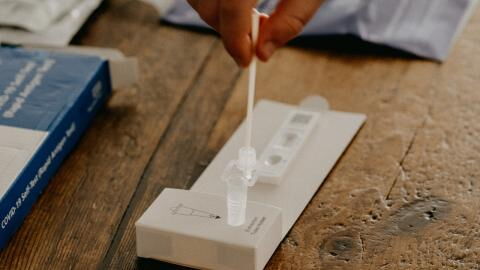Lateral flow tests will be replacing PCR tests for fully vaccinated travellers from the 24th of October, which is great news for those that hate having a Q-tip so far up their nose.
Discover our latest podcast
And even better, a new study has found that COVID lateral flow tests (LFTs) are actually more accurate than we once believed.
Lateral flow tests are 90% accurate in detecting infectious COVID cases
As part of their study, researchers used a new formula to test the effectiveness of LFTs, finding them to be around 80% effective at detecting any level of coronavirus infection and more than 90% accurate in identifying contagious people.
Previous research comparing LFTs to PCR tests questioned the former’s true efficacy, with one Liverpool paper even concluding they were only around 40% accurate.
However, the new study, conducted by researchers at the University College London, found that because LFTs don’t work the same way as a PCR test, the two just can’t be compared directly.
PCR tests are hugely reliable in detecting the presence of COVID-19’s genetic material in a patient, which can be present for weeks after a person is no longer infectious.
Meanwhile, LFTs work by detecting material from the surface proteins of the virus.
When taking these functional differences into account, LFTs were proven to be highly accurate. According to Professor Michael Mina from the Harvard School of Public Health, LFTs can ‘achieve even 100% sensitivity when viral loads are at their peak and therefore catch nearly everyone who is currently a serious risk to public health.’
He also explained that those who receive a mixed result of a negative LFT and a positive PCR test are likely they have the virus but are not at a peak transmissible state.
‘Like comparing apples and oranges’
Professor Irene Petersen at the UCL Institute of Epidemiology and Health Care, and the study’s lead author, explained: ‘Previous studies comparing the reliability of lateral flow tests and PCR tests could be potentially misleading because a PCR test is a marker of having been infected at some point within a certain window of time and does not necessarily mean someone is infectious when testing positive.’
In most validation studies, individuals were tested simultaneously with LFTs and PCR tests, with PCRs being used as a gold standard to say someone is ‘positive or negative.’
Professor Petersen continued: ‘The sensitivity of the LFTs was therefore evaluated by their ability to identify the same cases that the PCRs picked up. However, this is like comparing apples and oranges.’
43,000 people given false negative PCR test result
The news comes as 43,000 people were given false-negative COVID PCR results after previously testing positive through an LFT. The incident involved tests taken between the 8th of September and the 12th of October, mostly in southeast England.
The issue has so far been ruled as a technical problem at a private processing lab in Wolverhampton. The lab in question is now being investigated, and all testing has been suspended at the site. All those who may still be contagious are being contacted.
The UK Health Security Agency clarified that the incident was specific to the one testing lab and that there are no problems with the LFTs or the PCR COVID tests themselves.















